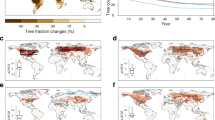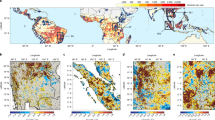Abstract
Deforestation in mid- to high latitudes is hypothesized to have the potential to cool the Earth’s surface by altering biophysical processes1,2,3. In climate models of continental-scale land clearing, the cooling is triggered by increases in surface albedo and is reinforced by a land albedo–sea ice feedback4,5. This feedback is crucial in the model predictions; without it other biophysical processes may overwhelm the albedo effect to generate warming instead5. Ongoing land-use activities, such as land management for climate mitigation, are occurring at local scales (hectares) presumably too small to generate the feedback, and it is not known whether the intrinsic biophysical mechanism on its own can change the surface temperature in a consistent manner6,7. Nor has the effect of deforestation on climate been demonstrated over large areas from direct observations. Here we show that surface air temperature is lower in open land than in nearby forested land. The effect is 0.85 ± 0.44 K (mean ± one standard deviation) northwards of 45° N and 0.21 ± 0.53 K southwards. Below 35° N there is weak evidence that deforestation leads to warming. Results are based on comparisons of temperature at forested eddy covariance towers in the USA and Canada and, as a proxy for small areas of cleared land, nearby surface weather stations. Night-time temperature changes unrelated to changes in surface albedo are an important contributor to the overall cooling effect. The observed latitudinal dependence is consistent with theoretical expectation of changes in energy loss from convection and radiation across latitudes in both the daytime and night-time phase of the diurnal cycle, the latter of which remains uncertain in climate models8.
This is a preview of subscription content, access via your institution
Access options
Subscribe to this journal
Receive 51 print issues and online access
$199.00 per year
only $3.90 per issue
Buy this article
- Purchase on Springer Link
- Instant access to full article PDF
Prices may be subject to local taxes which are calculated during checkout




Similar content being viewed by others
References
Bonan, G. B. Forests and climate change: forcings, feedbacks, and the climate benefits of forests. Science 320, 1444–1449 (2008)
Betts, R. A. Offset of the potential carbon sink from boreal forestation by decreases in surface albedo. Nature 408, 187–190 (2000)
Bala, G. et al. Combined climate and carbon cycle effects of large-scale deforestation. Proc. Natl Acad. Sci. USA 104, 6550–6555 (2007)
Bonan, G. B. et al. Effects of boreal forest vegetation on global climate. Nature 359, 716–718 (1992)
Davin, E. L. & De Noblet-Ducoudré, N. Climatic impact of global-scale deforestation: radiative versus nonradiative processes. J. Clim. 23, 97–112 (2010)
Rotenberg, E. & Yakir, D. Contribution of semi-arid forests to the climate system. Science 327, 451–454 (2010)
Juang, J.-Y. et al. Separating the effects of albedo from eco-physiological changes on surface temperature along a successional chronosequence in the southeastern United States. Geophys. Res. Lett. 34, L21408 (2007)
Pielke, R. A. et al. Unresolved issues with the assessment of multidecadal global land surface temperature trends. J. Geophys. Res. 112, D24S08 (2007)
Baldocchi, D. et al. FLUXNET: a new tool to study the temporal and spatial variability of ecosystem-scale carbon dioxide, water vapor and energy flux densities. Bull. Am. Meteorol. Soc. 82, 2415–2434 (2001)
Betts, A. K. & Ball, J. H. Albedo over the boreal forest. J. Geophys. Res. 102, D24, 28901–28909 (1997)
Douville, H. & Royer, J.-F. Influence of the temperate and boreal forests on the Northern Hemisphere climate in the Meteo-France climate model. Clim. Dyn. 13, 57–74 (1997)
Snyder, P. K. et al. Evaluating the influence of different vegetation biomes on the global climate. Clim. Dyn. 23, 279–302 (2004)
Betts, R. A. et al. Biogeophysical effects of land use on climate: model simulations of radiative forcing and large-scale temperature change. Agric. For. Meteorol. 142, 216–233 (2007)
von Randow, C. et al. Comparative measurements and seasonal variations in energy and carbon exchange over forest and pasture in south west Amazonia. Theor. Appl. Climatol. 78, 5–26 (2004)
Pielke, R. A. & Avissar, R. Influence of landscape structure on local and regional climate. Landscape Ecol. 4, 133–155 (1990)
Hansen, J. et al. in Climate Processes and Climate Sensitivity (eds Hansen, J. E. & Takahashi, T. ) 130–163 (American Geophysical Union, 1984)
Goulden, M. L. et al. An eddy covariance mesonet to measure the effect of forest age on land-atmosphere exchange. Glob. Change Biol. 12, 2146–2162 (2006)
Wild, M. et al. Impact of global dimming and brightening on global warming. Geophys. Res. Lett. 34, L04702 (2007)
Easterling, D. R. et al. Maximum and minimum temperature trends for the globe. Science 277, 364–367 (1997)
Mesinger, F. et al. North American regional reanalysis. Bull. Am. Meteorol. Soc. 87, 343–360 (2006)
Zhou, L. et al. Spatiotemporal patterns of changes in maximum and minimum temperatures in multi-model simulations. Geophys. Res. Lett. 36, L02702 (2009)
Mahrt, L. Surface heterogeneity and vertical structure of the boundary layer. Boundary-Layer Meteorol. 96, 33–62 (2000)
Swann, A. L. et al. Changes in Arctic vegetation amplify high-latitude warming through the greenhouse effect. Proc. Natl Acad. Sci. USA 107, 1295–1300 (2010)
Davin, E. L. et al. Impact of land cover change on surface climate: relevance of radiative forcing concept. Geophys. Res. Lett. 34, L13702 (2007)
Zha, T. et al. Carbon sequestration in boreal jack pine stands following harvesting. Glob. Change Biol. 15, 1475–1487 (2009)
Stoy, P. C. et al. Separating the effects of climate and vegetation on evapotranspiration along a successional chronosequence in the southeastern US. Glob. Change Biol. 12, 2115–2135 (2006)
Anderson, R. G. & Goulden, M. L. Relationships between climate, vegetation, and energy exchange across a montane gradient. J. Geophys. Res. 116, G01026 (2011)
Goulden, M. L. et al. Diel and seasonal patterns of tropical forest CO2 exchange. Ecol. Appl. 14, 42–54 (2004)
Sakai, R. et al. Land-use change effects on local energy, water, and carbon balances in an Amazonian agricultural field. Glob. Change Biol. 10, 895–907 (2004)
Acknowledgements
The data collection and analysis were supported in part by grants from the US Department of Energy and by a Yale University Climate and Energy Institute grant. We thank D. Fitzjarrald and R. Sakai for providing the data for the KM77 tropical site and C. von Randow for providing the friction velocity data for FLUXNET cluster e.
Author information
Authors and Affiliations
Contributions
X.L. developed the energy balance model, carried out the analysis and wrote the manuscript, M.L.G. and D.Y.H. contributed ideas to data analysis, M.L.G., D.Y.H., T.A.B., G.B., L.G., G.K., T.K., B.E.L., H.M., T.M., W.M., R.O., A.D.R., R.S. and S.W. contributed ideas to manuscript development, M.L.G., D.Y.H., A.B., T.A.B., G.B., R.B., B.D., A.G., L.G., G.K., T.K., B.E.L., X.L., H.M., T.M., R.M., W.M., R.O., K.T.P.U, A.D.R., H.P.S., R.S. and S.W. contributed data, and L.Z. performed the NARR data analysis.
Corresponding author
Ethics declarations
Competing interests
The authors declare no competing financial interests.
Supplementary information
Supplementary Information
The file contains Supplementary Text and Data, Supplementary References, Supplementary Tables 1-3 and Supplementary Figures 1-4 with legends. (PDF 445 kb)
Supplementary Data 1
This file comprises: 1 Comparison between weather station and NARR screen height temperature (annual mean, Jan mean and July mean) in NARR cells in closest proximity to the station lat/long; 2 NARR diurnal temperature range for NARR cells in closest proximity to forest eddy covariance sites; 3 Summary of temperature statistics for forests and the closest matching weather stations & summary of net radiation data for the forest sites; 4 Year-by-year summary of temperature statistics for each forest/station pair; 5 Year-by-year NARR temperature data at NARR grid matching the paired weather station; 6 Data used for energy balance / factor separation analysis; 7 Data used for analysis of sensitivity to heat storage, FLUXNET cluster a. (XLS 277 kb)
Supplementary Data 2
The file contains monthly temperature data for the site pairs including lapse rates derived from NARR. (TXT 29 kb)
Rights and permissions
About this article
Cite this article
Lee, X., Goulden, M., Hollinger, D. et al. Observed increase in local cooling effect of deforestation at higher latitudes. Nature 479, 384–387 (2011). https://doi.org/10.1038/nature10588
Received:
Accepted:
Published:
Issue Date:
DOI: https://doi.org/10.1038/nature10588
This article is cited by
-
Changes in albedo and its radiative forcing of grasslands in East Asia drylands
Ecological Processes (2024)
-
Uncertainties in measuring precipitation hinders precise evaluation of loss of diversity in biomes and ecotones
npj Climate and Atmospheric Science (2024)
-
Assessment of seasonal warming trends at the Nile Delta: a paradigm for human-induced climate change
Environmental Monitoring and Assessment (2024)
-
Biophysical impacts of earth greening can substantially mitigate regional land surface temperature warming
Nature Communications (2023)
-
Transient vegetation degradation reinforced rapid climate change (RCC) events during the Holocene
npj Climate and Atmospheric Science (2023)
Comments
By submitting a comment you agree to abide by our Terms and Community Guidelines. If you find something abusive or that does not comply with our terms or guidelines please flag it as inappropriate.



